This post may contain affiliate links. Please see our disclosure policy.
Tulip jelly is a delicate floral preserve made from fresh tulip petals, with a light, slightly fruity flavor and a soft, jewel-toned color. It’s a beautiful way to enjoy edible flowers in a sweet and unique way.
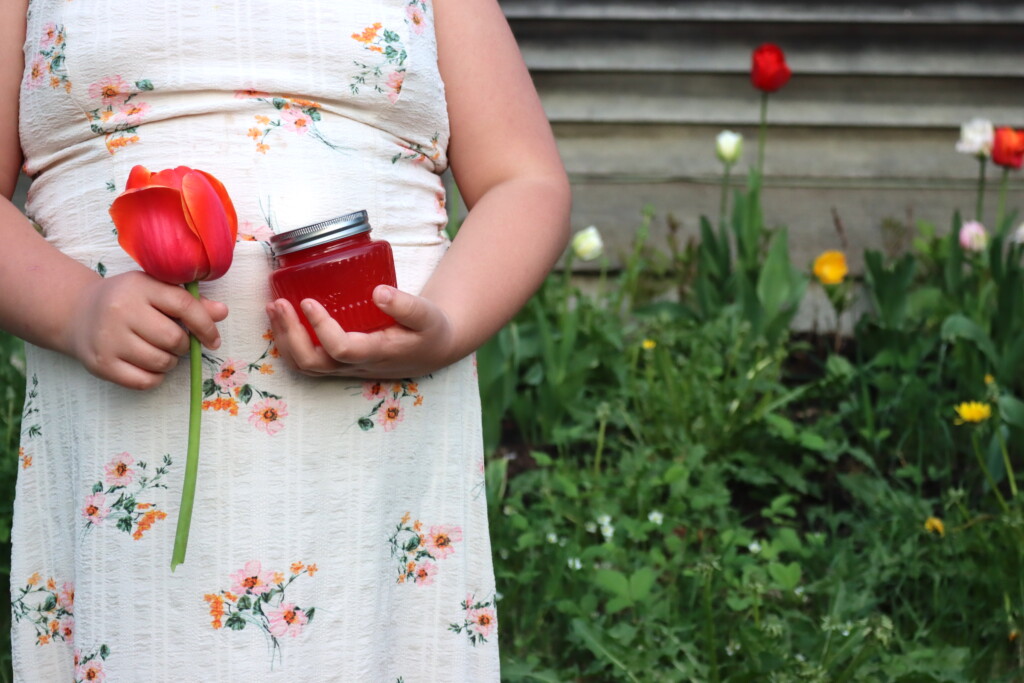
Tulip jelly might sound unusual, but these spring flowers aren’t just beautiful in the garden—they’re also edible, and surprisingly flavorful. Tulip petals have a light, crisp taste that ranges from sweet to slightly cucumber-like, depending on the color and variety. When turned into jelly, tulips create a mild floral preserve with a delicate hint of fruit and a lovely jewel-toned hue.
Like other flower jellies, tulip jelly begins with a simple infusion made from the petals. The color of your jelly will depend on the color of the tulips you use—reds and purples yield deeper hues, while yellow or white petals result in a more golden jelly. With a splash of lemon juice and a touch of sugar, the final result is a beautifully unexpected way to enjoy the spring tulip bloom long after the flowers fade.
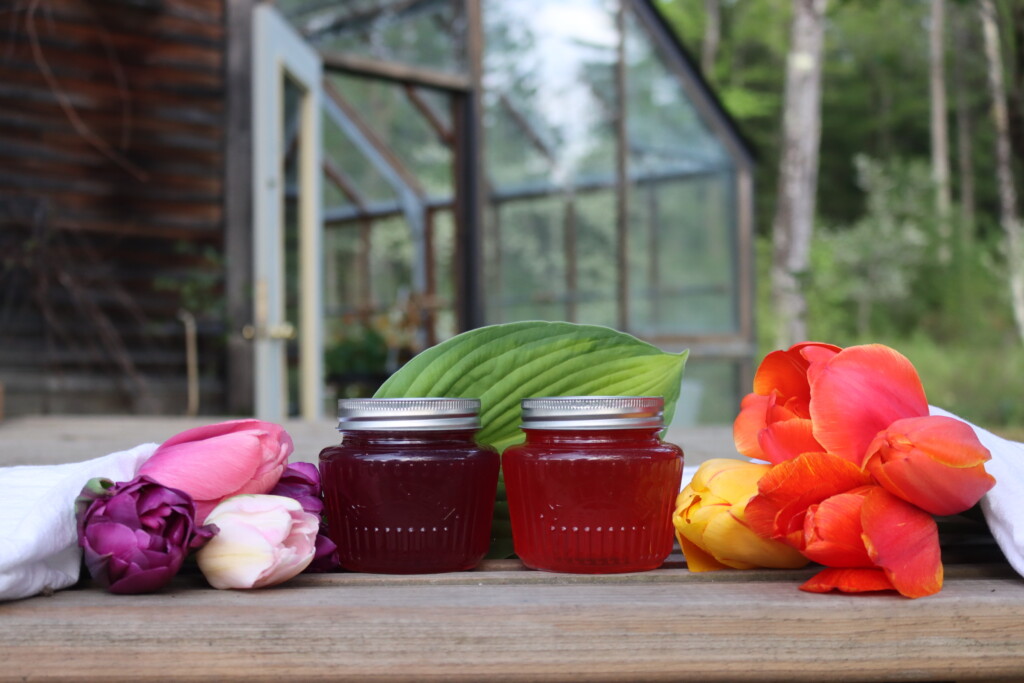
A Quick Look at the Recipe
- Recipe Name: Tulip Jelly
- Recipe Type: Flower Jelly Recipe
- Canning Method: Waterbath Canning
- Prep/Cook Time: 30 Minutes
- Canning Time: 10 Minutes
- Yield: 4 to 5 half pint jars
- Jar Sizes: Quarter Pint, Half Pint or Pint
- Headspace: 1/4 inch
- Ingredients Overview: Edible Flowers, Water, Lemon Juice (not optional), and sugar
- Difficulty: Easy! You’re basically making a quick tea and setting it with pectin.
- Similar Recipes: The process is very similar to making other edible garden flower jellies, including Peony Jelly, Pansy Jelly, Forsythia Jelly, Lilac Jelly or Rose Petal Jelly.
Are Tulips Edible?
Yes, tulips are indeed edible—and not just for show! While they’re best known for brightening up spring gardens, tulip petals can also be used in the kitchen. People are often surprised to learn that these flowers are safe to eat, but they’ve actually been used as food and decoration in various cultures for centuries.
Tulip petals have a mild, crisp flavor that varies depending on the color and variety. Some are slightly sweet and fruity, while others have a clean, cucumber-like taste. Red and pink tulips tend to be a bit more floral, while yellow and white varieties are milder and more neutral. The texture is soft but sturdy, making them useful not only in jellies but also in salads or as natural serving cups for soft cheeses or fillings.
Important Note
Avoid flowers that have been treated with pesticides or commercial floral preservatives. Always use organically grown tulips or ones you’ve grown yourself without chemicals.
Ingredients for Tulip Jelly
The ingredients are pretty much the same as any other homemade flower jelly, just with tulips!
- Tulip Petals – Choose 2 to 4 cups of fresh, unsprayed petals. Make sure the flowers are fully opened and free from any bitter green parts or inner reproductive structures (like stamens or pistils), which should be removed.
- Water – Used to create the tulip infusion, this becomes the base for your jelly.
- Lemon Juice – Adds brightness and acidity, helps the jelly set, and can shift the color depending on petal pigments. It’s also required to make the flower jelly safe for canning, so don’t skip it!
- Powdered Pectin – Essential for thickening the jelly into a spreadable consistency.
- Granulated Sugar – Sweetens the jelly and helps preserve it. The typical ratio is 1:1 with the infusion, though low-sugar options are possible.
Tulips give a lovely color to the jelly, and the finished look will depend on the particular tulips you’ve chosen. I recommend sticking with one color or range of colors (ie. orange/yellow in one batch or blue/purple in another). If you mix them, the color will be more of a brown, rather than the bright hues you get when you stick with similar colors in each batch.
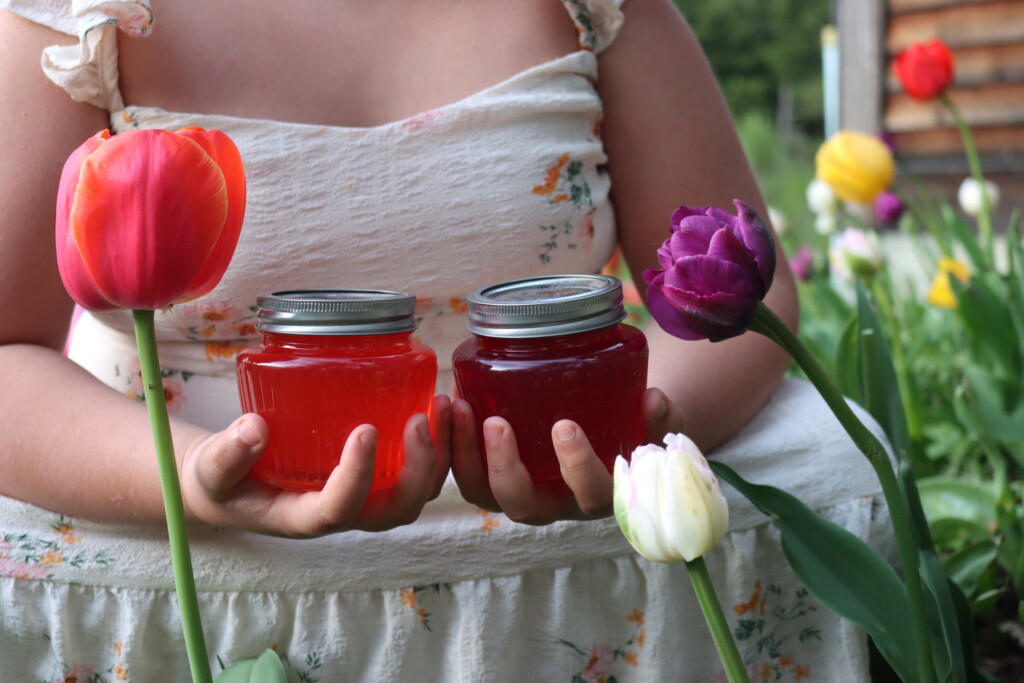
How to Make Tulip Jelly
Start by harvesting fresh tulip petals. Use tulips that haven’t been treated with pesticides or floral preservatives—those from your own yard or an organic grower are best.
Carefully pull the petals from the flower heads, and remove any internal flower parts (such as the stamens and pistil), which can be bitter. You’ll need 2 to 4 cups of petals.
Place the petals in a heatproof bowl or quart jar. Pour 4 cups of boiling water over them. Cover and let steep for 15 to 20 minutes. As the petals soak, they’ll release their subtle flavor and color into the liquid, creating a fragrant tulip tea.
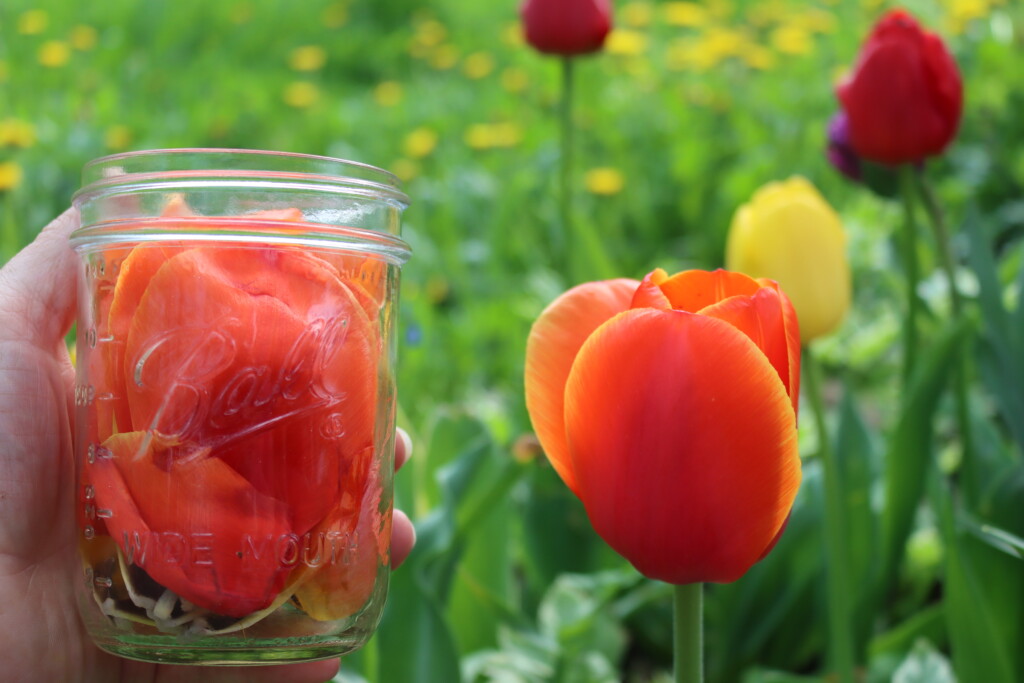
While the petals are steeping, prepare your water bath canner if you plan to preserve the jelly. Make sure your jars, lids, and rings are clean and sterilized, and bring the water in the canner to a simmer.
After steeping, strain the tulip tea through cheesecloth or a fine mesh sieve to remove the petals. You should be left with about 4 cups of floral infusion. Stir in 2 tablespoons of lemon juice, which enhances both the flavor and the pectin’s ability to set the jelly.
Pour the tea into a large saucepan and bring it to a boil. Stir in one box (1.75 oz) of powdered pectin, and let it boil hard for one minute, stirring constantly. Only after the pectin has fully dissolved should you add the sugar. Stir in 4 cups of granulated sugar and return the mixture to a full rolling boil for another minute.
Remove from heat and immediately ladle the hot jelly into sterilized jars, leaving 1/4 inch of headspace. Wipe the rims clean, apply lids, and screw on bands until fingertip-tight.
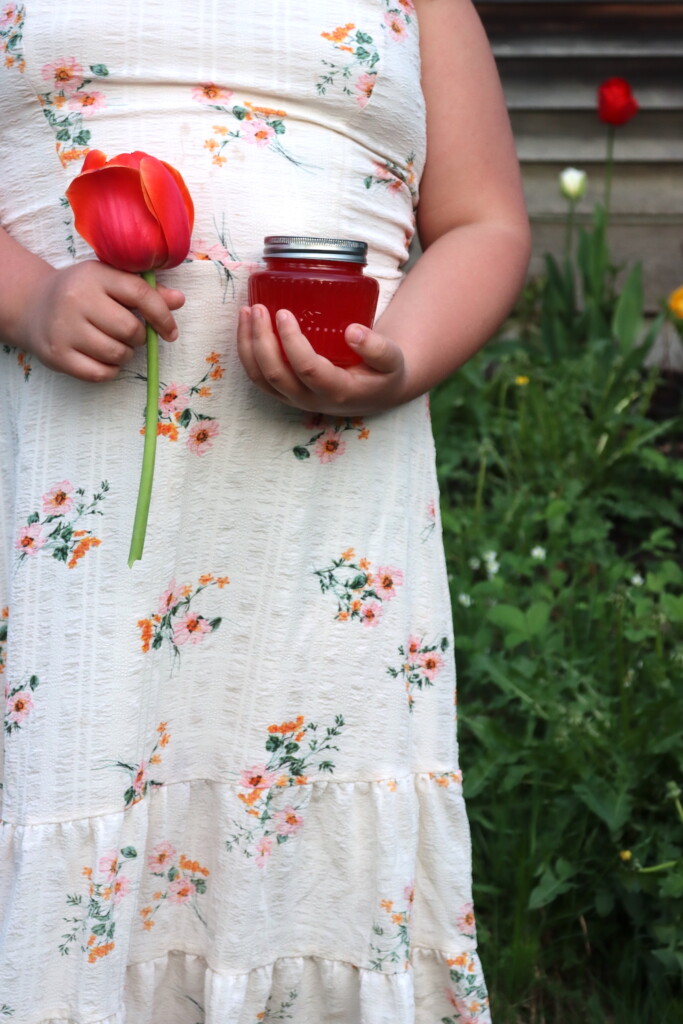
Canning Tulip Jelly
Process the jars in a boiling water bath canner for 10 minutes (or 15 minutes if you’re above 6,000 feet in elevation). Let the jars cool undisturbed on a towel-lined surface for 12–24 hours.
You’ll hear the satisfying pop of the seals setting. Any unsealed jars should be refrigerated and used within a month.
Properly processed jars can be stored in a cool, dark pantry for up to 18 months.
Notes on Sugar & Yield
Expect around 5 half-pint jars (8 oz each) when using full sugar and standard pectin. Low-sugar versions may yield slightly less, around 3 to 4 jars.
Using standard powdered pectin, you’ll need a 1:1 ratio of liquid to sugar (4 cups each) for proper gel and sweetness. For a lighter jelly, you can opt for low-sugar pectin like Sure-Jell Low Sugar or Pomona’s Universal Pectin, which allows for reduced or no sugar jellies. Follow the package directions for these alternatives—Pomona’s mint jelly recipe is a good match.Avoid using liquid pectin, which requires significantly more sugar (typically 7 cups per 4 cups of liquid) and can overpower the mild floral flavor of tulip jelly.
If you tried this Tulip Jelly Recipe, or any other recipe on Creative Canning, leave a ⭐ star rating and let me know what you think in the 📝 comments below!
And make sure you stay in touch with me by following on social media!
Edible Flower Jellies
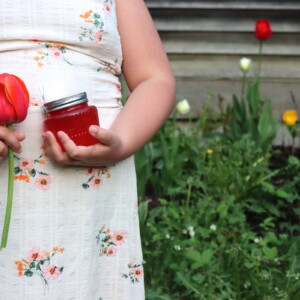
Tulip Jelly
Equipment
Ingredients
- 2 to 4 cups fresh tulip petals, cleaned, stamens removed
- 4 cups boiling water
- 2 tbsp fresh lemon juice
- 1 box Powdered Pectin, 1.75 oz or 6 Tbsp powdered pectin such as Sure Jel
- 4 cups granulated sugar, See Notes
Instructions
- Gently rinse and prepare tulip petals, removing stamens and pistils. Place in a large heatproof bowl or jar.
- Pour 4 cups of boiling water over the petals. Cover and steep for 15–20 minutes.
- Strain through a fine mesh sieve or cheesecloth. You should have about 4 cups of tulip tea.
- Stir in the lemon juice and pour the mixture into a large saucepan. Bring to a boil.
- Add pectin and boil for 1 full minute, stirring constantly.
- Add sugar and stir until dissolved. Return to a rolling boil and cook for another full minute.
- Remove from heat. Ladle hot jelly into sterilized jars, leaving 1/4 inch headspace. Wipe rims and seal with lids and rings.
- If cannning: Process in a boiling water bath for 10 minutes (or 15 minutes above 6,000 ft).
- Let jars cool undisturbed. Store sealed jars in a cool, dark place for up to 18 months. Refrigerate after opening. If not canned, it'll keep in the fridge for a few weeks.
Notes
Tips on Sugar and Yield
If you’re using regular powdered pectin (such as Sure-Jell), plan on using equal parts sugar and tulip tea to get a firm, reliable set—typically 4 cups of sugar for 4 cups of floral liquid. This makes a classic, sweet jelly with a familiar texture. For a lighter, less sugary version, opt for a low-sugar pectin like Sure-Jell Low Sugar. With this type, you can reduce the sugar to as little as 1 to 2 cups and still get a good set. Just keep in mind that using less sugar usually means a smaller final yield, closer to 3 or 4 jars instead of 5. Pomona’s Universal Pectin is another excellent choice for flexible sugar levels. It uses a different process involving calcium water and can handle low- or no-sugar recipes well. For tulip jelly, following Pomona’s mint jelly instructions is a solid starting point. Skip liquid pectin for this one—it calls for a much higher sugar content (up to 7 cups for 4 cups of liquid), which can easily overpower the tulip’s mild floral flavor.Nutrition
Nutrition information is automatically calculated, so should only be used as an approximation.
Flower Jelly Recipes
If you enjoyed making tulip jelly, you might also like other floral jellies.
Dandelion jelly tastes like sunshine with a honeyed finish, while clover jelly is sweet and grassy. Apple blossom jelly is soft and floral, capturing the scent of spring orchards. Nasturtium jelly adds a peppery twist, great for savory pairings.
Forsythia jelly is bright and lemony, and grape hyacinth jelly offers a gorgeous color and light floral flavor. Each one is a beautiful way to bring the spring garden into your pantry.
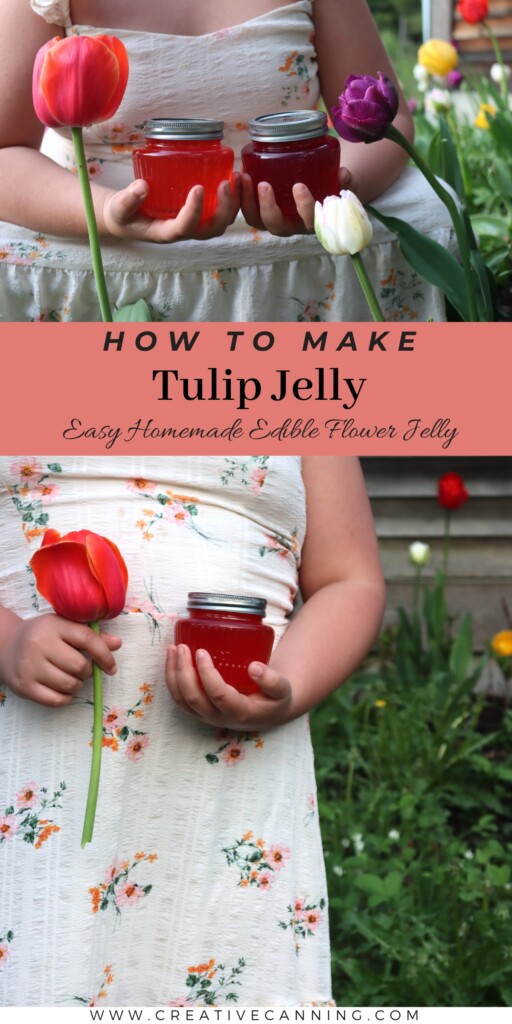

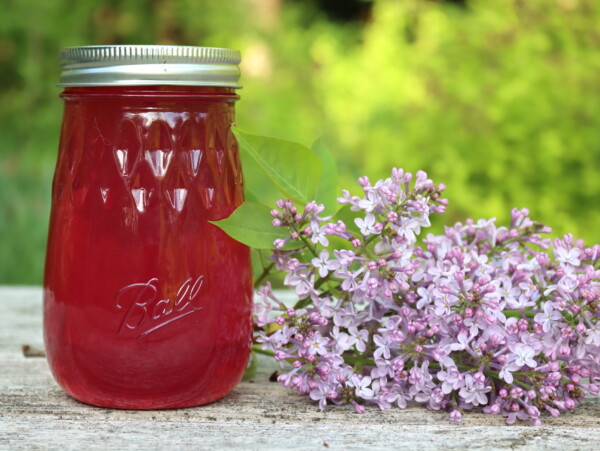
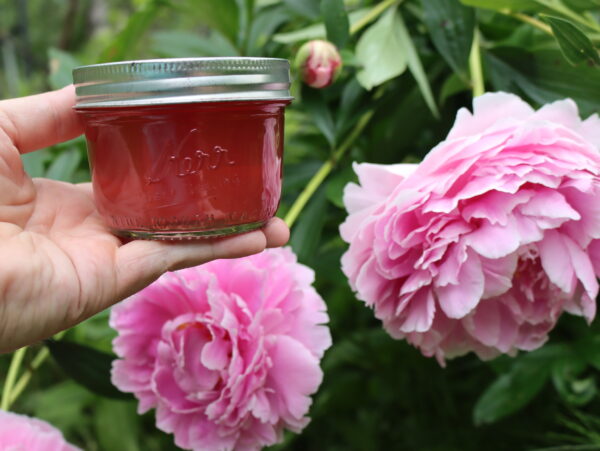

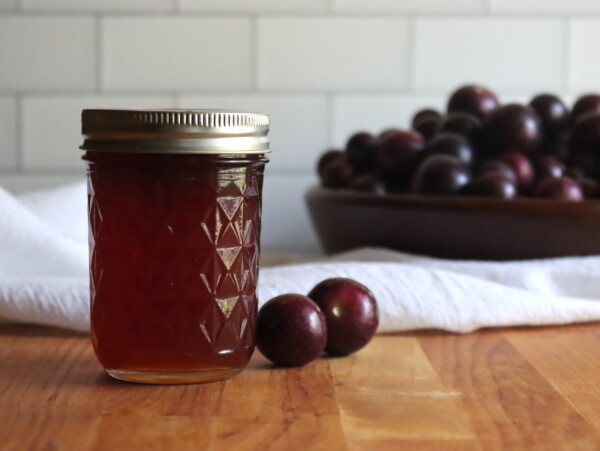
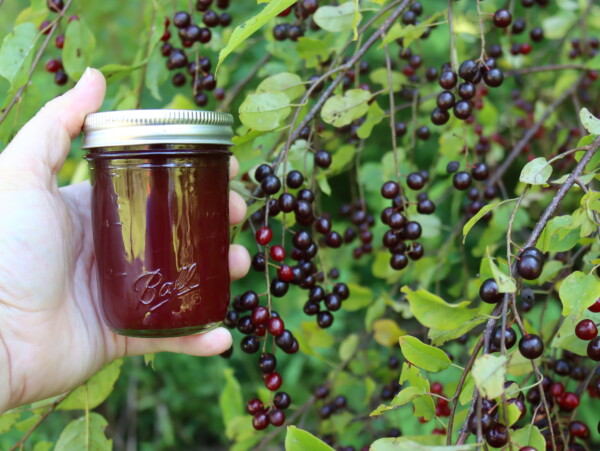

My daughter loves EVERY flower jelly recipe, and now that she knows you can eat tulips she’s helping me plant a big patch of them in the front garden.